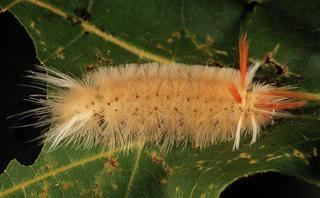Rank Species | ||
 | ||
Similar Halysidota, Halysidota tessellaris, Haploa clymene, Orgyia leucostigma, Hypoprepia fucosa | ||
Catepillar halysidota harrisii cool looking
Halysidota harrisii (sycamore tussock moth) is a species of moth of the family Erebidae. It is found in South-Eastern Canada, the Eastern parts of the United States (but not Florida) and North-Eastern Mexico. The wingspan is about 50 mm. The moth flies from May to June and from July to August depending on the location.
Contents

The larvae feed on the American sycamore tree (Platanus occidentalis). Unfortunately, an overpopulation of the insect can be damaging to sycamore trees. The ideal way to manage the moth and caterpillar populations is to foster a healthy bird population.

The sycamore tussock moth caterpillar has been known to cause urticaria (hives) to those who touch its hairs. This defense mechanism protects the caterpillar from potential predators. If you find a sycamore tussock moth crawling on you, do not pick it up or swat at it. Use a folded piece of paper or stick to gently remove it. Acting aggressively toward the caterpillar increases the likelihood of exposure to those defensive hairs. Look but do not touch.

Halysidota harrisii 07 23 15 2

